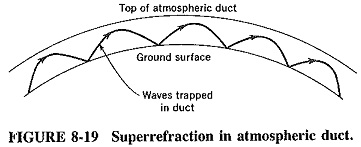Space Waves:
Space waves generally behave with merciful simplicity. They travel in (more or less) straight lines! However, since they depend on line-of-sight conditions, space waves are limited in their propagation by the curvature of the earth, except in very unusual circumstances. Thus they propagate very much like electromagnetic waves in free space. Such a mode of behavior is forced on them because their wavelengths are too short for reflection from the ionosphere, and because the ground wave disappears very close to the transmitter, owing to tilt.
Radio horizon:
The radio horizon for space waves is about four-thirds as far as the optical horizon. This beneficial effect is caused by the varying density of the atmosphere, and because of diffraction around the curvature of the earth. The radio horizon of an antenna is given, with good approximation, by the empirical formula
where
dt = distance from transmitting antenna, km
ht = height of transmitting antenna above ground, m
The same formula naturally applies to the receiving antenna. Thus the total distance will be given by addition, as shown in Figure 8-18, and by the empirical formula
A simple calculation shows that for a transmitting antenna height of 225 m above ground level, the radio horizon is 60 km. If the receiving antenna is 16 m above ground level, the total distance is increased to 76 km. Greater distance between antennas may be obtained by locating them on tops of mountains, but links longer than 100 km are hardly ever used in commercial communications.
As we know any tall or massive objects will obstruct space waves, since they travel close to the ground. Consequently, shadow zones and diffraction will result. This is the reason for the need in some areas for antennas higher than would be indicated by Equation (8-14). On the other hand, some areas receive such signals by reflection any object large enough to cast a radio shadow will, if it is a good conductor, cause back reflections also. Thus, in areas in front of it a form of interference known as “ghosting” may be observed on the screen of a television receiver. It is caused by the difference in path length (and therefore in phase) between the direct and the reflected rays. This situation is worse near a transmitter than at a distance, because reflected rays are stronger nearby. Finally, particularly severe interference exists at a distance far enough from the transmitter for the direct and the ground-reflected rays to be received simultaneously.
Microwave Space Wave Propagation:
All the effects so far described hold true for microwave frequencies, but some are increased, and new ones are added. Atmospheric absorption and the effects of precipitation must be taken into account. So must the fact that at such short wavelengths everything tends to happen very rapidly. Refraction, interference and absorption tend to be accentuated. One new phenomenon which occurs is superrefraction, also known as ducting.
As previously discussed, air density decreases and refractive index increases with increasing height above ground. The change in refractive index is normally linear and gradual, but under certain atmospheric conditions a layer of warm air may be trapped above cooler air, often over the surface of water. The result is that the refractive index will decrease far more rapidly with height than is usual. This happens near the ground, often within 30 m of it. The rapid reduction in refractive index (and therefore dielectric constant) will do to microwaves what the slower reduction of these quantities, in an ionized layer, does to HF waves; complete bending down takes place, as illustrated in Figure 8-19. Microwaves are thus continuously refracted in the duct and reflected by the ground, so that they are propagated around the curvature of the earth for distances which sometimes exceed 1000 km. The main requirement for the formation of atmospheric ducts is the so-called temperature inversion. This is an increase of air temperature with height, instead of the usual decrease in temperature of 6.5°C/km in the “standard atmosphere.” Superrefraction is, on the whole, more likely in subtropical than in temperate zones.

